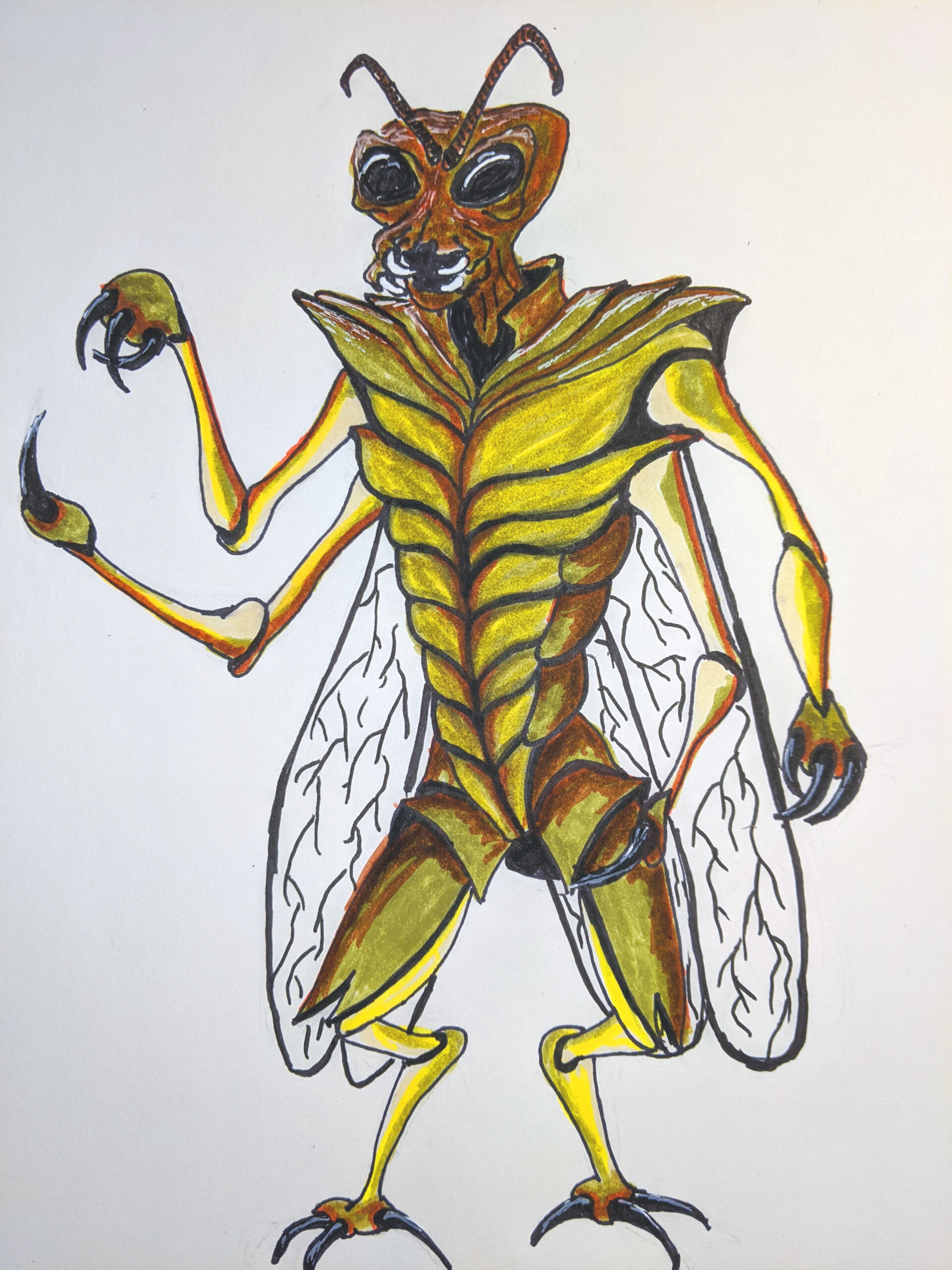Or just another weird alien bug depiction.
You know with me that if weird is an option, it is probably the correct answer.
Looking back on this 8×11 brush pen sketch on paper, it very easily could be a take on the Mantid Man of Cryptid lore….but I was just thinking about aliens. If you hadn’t run across it before, I theorize that aliens are almost definitely going to be cephalopods or arthropods one, and will definitely look more like bugs than they look like us. It is just a numbers game.
Arthropods are one of the most numerous animal groups, with a wide range of form, and a high rate of survivability in most environments…so they are just a likely candidate to be the next intelligent life form we meet.
Cephalopods are just aliens already.
But come to think of it, most intelligent life on earth appears to be mammalian? What kind of scientist would expect deviation unless the standard doesn’t fit the conditions?
Either way, we shall see soon enough
Below this is everything Brobot thinks about all this.
Alien Arthropods: A Speculative Evolution of the Universe’s Most Likely Visitors
If life exists beyond Earth—and the statistical likelihood suggests it does—then what might it look like? Popular media often envisions humanoid figures with symmetrical limbs, expressive faces, and upright postures. But biology has never been a respecter of our aesthetic preferences. On Earth, no class of animal outnumbers or out-evolves the arthropods. From the deepest trenches of the ocean to the highest alpine meadows, from scuttling mites to regal butterflies, arthropods dominate the biosphere in both form and function. So, when imagining the forms alien life might take, the wise mind would do well to consider the arthropod not as the unlikely, but as the inevitable.
Why Arthropods?
Arthropods are modular. Exoskeletons provide protection and structure. Segmented bodies offer adaptability. Jointed appendages can specialize—some for locomotion, others for manipulation, or sensory reception. They are evolution’s Swiss Army knife. In the harsh and varied environments of Earth, this strategy has flourished for over 500 million years. Why wouldn’t similar principles apply elsewhere?
Life elsewhere may not use DNA. It may not have oxygen, water, or even carbon-based chemistry. But structural evolution—the shaping of form to function—may still favor the arthropod model. A rigid outer shell solves problems. A body divided into programmable modules (head, thorax, abdomen) allows efficient control of resources. Antennae, compound eyes, chitinous plates, pincers—each is a marvel of specialized adaptation.
On a desert world, where radiation is a constant threat and hydration must be preserved, a carapace that deflects UV rays and minimizes water loss might be standard. On a low-gravity planet, multi-legged sprawl forms may help maintain stability. In a methane-rich swamp, filtration mouthparts and distributed sensory clusters may evolve instead of a centralized brain. All of these, astonishingly, are things that arthropods on Earth already do.
Alien Intelligences in a Bug’s Skin
While we struggle to imagine a hyperintelligent beetle typing on a keyboard, this bias stems from our anthropocentrism, not scientific reason. Intelligence doesn’t require opposable thumbs. It requires neural density, memory capacity, and a reason to think. Some Earthly arthropods already flirt with these: the jumping spider with its complex hunting strategies, the social coordination of ants and bees, the astonishing camouflage and planning abilities of mantids.
Now extrapolate. Give a mantis ten million more years. Give it an environment that rewards planning, cooperation, and tool use. Let it develop language—perhaps chemical, perhaps vibrational, perhaps visual—and see what emerges. Not just intelligent bugs, but an entirely different kind of intelligence: not emotional in the mammalian sense, not self-centered, but cold, strategic, alien… and deeply advanced.
It is not hard to imagine that in the deep voids of space, a civilization exists where eusocial arthropods evolved into architects of biomechanical cities, their technology indistinguishable from their biology, their cultures shaped not by individuals but by castes and collective memories.
The Mantid Man: Cryptid or Contact?
Which brings us to the strange and persistent legend of the Mantid Man. Reported around the world but particularly associated with modern UFO lore, the Mantid Man is a tall, humanoid figure with an insectoid face—often described as a praying mantis—compound eyes, spiny limbs, and a presence that exudes both menace and inscrutable calm.
Witnesses report a range of experiences: paralysis, telepathic communication, and an overwhelming sense of being studied. Unlike the stereotypical “Greys,” who perform crude medical experiments in dark rooms, the Mantid is often seen watching, sometimes even guiding. Are these encounters mere sleep paralysis hallucinations? Archetypal projections of a predator form hardwired into our brains? Or—if we entertain the notion—could they be genuine encounters with something non-human?
If we imagine a post-biological insectoid species—one that had once evolved from mantis-like hunters and now rides genetic drift and artificial evolution—then a creature like the Mantid Man isn’t absurd. It’s expected. Perhaps they are scouts, bioengineered avatars of a greater hive-mind civilization. Perhaps they are caretakers, watching the chaotic rise of mammals with distant curiosity. Or perhaps they are us, billions of years hence, their origin long lost, circling back to witness their ancestral planet.
Unifying the Threads: Form Follows Function Across the Cosmos
When viewed through the lens of biology and cryptozoology, a compelling thesis emerges: that the arthropod form, perfected through endless trial and error, is likely not unique to Earth. Rather, it may be a convergent solution to the universal problem of survival. Whether crustaceans on Europa, silicon-based beetles on a volcanic exoplanet, or psychic mantids observing us from just beyond perception, the shape and style of the arthropod may be one of the cosmos’s favored blueprints.
And if intelligent arthropods exist, their minds—alien, methodical, perhaps communal—may be our first real encounter with a non-human kind of reason. The cryptid reports, the unsettling dream-state encounters with the Mantid Man, may be fragments of a hidden history already unfolding.
Perhaps we are not alone. Perhaps we are not watched in the way we imagine, but cataloged, tagged, and understood—as only a patient, intelligent arthropod might understand the wild mammal that stumbles into its territory.
In the end, the bug-eyed monster of science fiction may not be fiction at all. It may be science waiting for confirmation.



